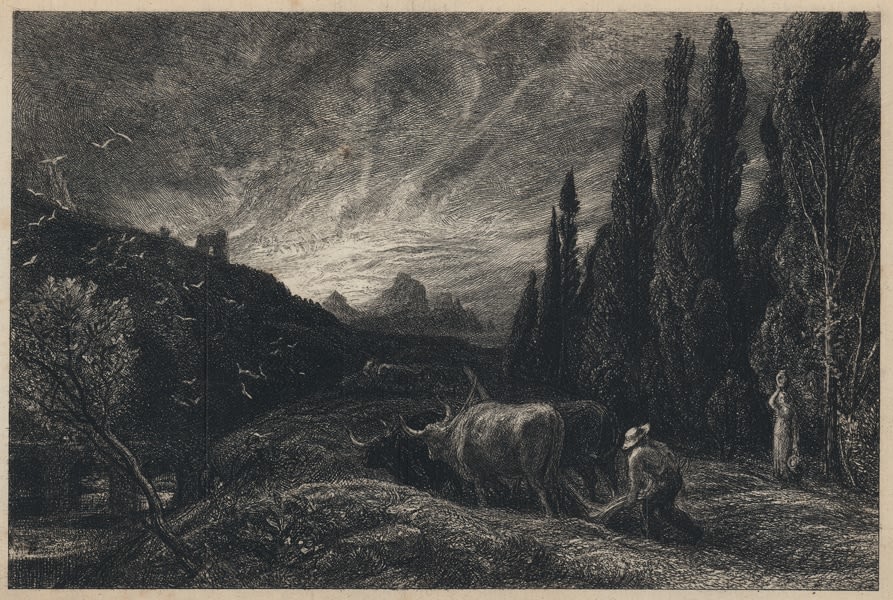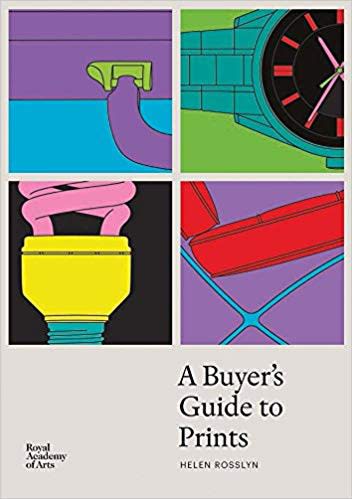Samuel Palmer
The Early Ploughman, or, The Morning Spread upon the Mountains, 1861 (1868 impression)
Etching
13.5 x 19.8 cm
5 1/4 x 7 3/4 in
5 1/4 x 7 3/4 in
Sanders of Oxford
Online only
Online only
£ 2,000.00
An atmospheric rural scene showing a ploughman and three oxen driving a plough through the field at the break of day. A row of cypress trees is seen to the...
An atmospheric rural scene showing a ploughman and three oxen driving a plough through the field at the break of day. A row of cypress trees is seen to the right, with a female figure seen standing at the field edge with a pot on their head and a basket in their hand. In the background a dramatic hill and landscape can be seen with the remains of a tower on the hilltop to the left. Published in Philip Gilbert Hamerton's 1868 'Etching and Etchers'.
Samuel Palmer (1805 – 1881) was a visionary artist and contemporary of William Blake. A key figure in British Romanticism he was also a prolific writer as well as a watercolourist, etcher and printmaker. Palmer is best known for his early works executed at Shoreham where he lived between 1826 to 1835. Introduced to William Blake by John Linnel (whose daughter he would later marry) Palmer and artists George Richmond and Edward Calvert formed a group named The Ancients who were characterised by their admiration for the work of William Blake and their attraction to archaism in art.
Like many great artists, it was not until after death that the works of Samuel Palmer were rediscovered and finally afforded the attention they deserved. Although his watercolours were popular in England at the time, Palmer struggled financially throughout his life time and had to divert much of his attentions to teaching to support himself and his wife, Hannah Linnel. After his death in 1881, Samuel Palmer was largely forgotten, his surviving son, Alfred Herbert Palmer, even went as far as to burn a large portion of his fathers work in 1901, stating that: "Knowing that no one would be able to make head or tail of what I burnt; I wished to save it from a more humiliating fate".
In 1926 Martin Hardie curated a show at the Victoria and Albert Museum entitled Drawings, Etchings and Woodcuts made by Samuel Palmer and other Disciples of William Blake. This kick-started the revival of interest in Palmer’s work which subsequent retrospective exhibitions and publications have continuously reinforced throughout the rest of the 20th century. The Shoreham work in particular has had a notable influence on several important 20th century artists such as Frederick Landseer Griggs, Robin Tanner, Graham Sutherland, Paul Drury and Eric Ravilious.
Alexander 9 iv/viii, Lister 9 v/ix
Condition: Toning from previous mount. Minor spots of foxing to sheet. Tape remnants top upper and lower sheet edges.
Samuel Palmer (1805 – 1881) was a visionary artist and contemporary of William Blake. A key figure in British Romanticism he was also a prolific writer as well as a watercolourist, etcher and printmaker. Palmer is best known for his early works executed at Shoreham where he lived between 1826 to 1835. Introduced to William Blake by John Linnel (whose daughter he would later marry) Palmer and artists George Richmond and Edward Calvert formed a group named The Ancients who were characterised by their admiration for the work of William Blake and their attraction to archaism in art.
Like many great artists, it was not until after death that the works of Samuel Palmer were rediscovered and finally afforded the attention they deserved. Although his watercolours were popular in England at the time, Palmer struggled financially throughout his life time and had to divert much of his attentions to teaching to support himself and his wife, Hannah Linnel. After his death in 1881, Samuel Palmer was largely forgotten, his surviving son, Alfred Herbert Palmer, even went as far as to burn a large portion of his fathers work in 1901, stating that: "Knowing that no one would be able to make head or tail of what I burnt; I wished to save it from a more humiliating fate".
In 1926 Martin Hardie curated a show at the Victoria and Albert Museum entitled Drawings, Etchings and Woodcuts made by Samuel Palmer and other Disciples of William Blake. This kick-started the revival of interest in Palmer’s work which subsequent retrospective exhibitions and publications have continuously reinforced throughout the rest of the 20th century. The Shoreham work in particular has had a notable influence on several important 20th century artists such as Frederick Landseer Griggs, Robin Tanner, Graham Sutherland, Paul Drury and Eric Ravilious.
Alexander 9 iv/viii, Lister 9 v/ix
Condition: Toning from previous mount. Minor spots of foxing to sheet. Tape remnants top upper and lower sheet edges.





 A Buyer's Guide to Prints
A Buyer's Guide to Prints